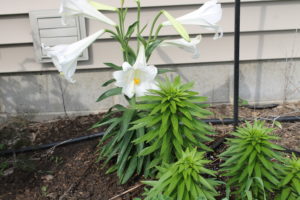 Many of us buy Easter lilies. But how do you care for them after Easter?
Many of us buy Easter lilies. But how do you care for them after Easter?
Growing up, I don’t remember anyone in my family ever buying Easter lilies. They were one of the plants my mom thought were a waste since she figured after it was done flowering, the whole plant needed to go in the trash.
The good news if you, like me, bought and Easter lily this year, it’s not necessarily destined for the compost pile. With a little care and patience, you may have a spot in your garden where this bulb can live to bloom again.
A Little Background
The plant we know as the Easter lily, Lilium longiflorum, is native to the southern islands of Japan, and it naturally flowers in the summer. Producing quality bulbs for sale depends on very specific climate conditions.
In the U.S., a small area at the Oregon-California border with only ten farms has the perfect environment for Easter lily bulb production. Some people call this coastal zone the “Easter Lily Capital of the World.” Amazingly, these ten farms produce all the Easter lily bulbs for the U.S. and Canada.
Greenhouse growers take these bulbs from the west coast, and by manipulating the temperature, moisture, and light, they can force them to bloom earlier than they would naturally. Then we buy the blooming plants for Easter. This process is a lot more complex than it sounds since the date of Easter changes each year.
Easter falls on the first Sunday following the first full moon of spring. Depending on this date, there may be more or less natural light available in the greenhouse, affecting how much artificial light is needed. It also affects when to plant the bulbs. They need about a thousand hours of cool, moist conditions to initiate blooming. Of course, the grower has to take all of this into account.
Easter Lilies in Bloom
Hopefully, if you bought an Easter lily this year, you managed to get one that still had some unopened buds. Keep the plant blooming by watering as the soil dries out. Make sure that you remove any plastic sleeves around the plant to allow water to drain away. Sitting the pot in standing water encourages root rot.
You can lengthen the life of individual flowers by removing the pollen-producing yellow anthers. This will also prevent pollen stains on the flowers and your tablecloth! Keeping the plants relatively cool, at 60 to 65 °F, cooler at night, and avoiding hot or cold drafts, also lengthens bloom time. Keep the plant moist, not wet, in indirect bright light, and you will be rewarded with weeks of flowers.
All parts of the Easter lily are poisonous, especially to cats, causing kidney failure and even death if untreated. If your cat eats any amount of your Easter lily, even just a dusting of pollen, see your veterinarian immediately.
After the Flowers Have Bloomed, or When You Cry Uncle
Easter lilies may be planted out in the garden after the last frost. Where I am in central Illinois, we figure around May 15th, or Mother’s Day is our frost-free date. That said I’m ignoring my own advice and planting my Easter lily today, while it’s still blooming.
Why? Well, my Easter lily is stinking up my house. Lilies are generally fragrant, including Easter lilies, but this one is not pleasant, to put it mildly. I’ve had Easter lilies before, and I don’t remember them smelling bad. There are several cultivars of Easter lily, so I guess I picked one of the stinkier ones this year.
When I bought my Easter lily, only a couple of blooms were open, and there were five more still to open. The stench ramped up slowly, and for the first few days I would take the trash out, thinking one of my daughter’s dirty diapers was the culprit. I even picked my daughter up and smelled her a few times. My husband thought the kitchen reeked of celery—which I guess I could smell, but when I said I thought it smelled more like old diapers, my husband said, “yeah, or that.”
At any rate, our Easter lily was evicted to the patio the day after Easter, and I’m going to go ahead and plant it. I figure that gives it a better chance of survival because it’s highly likely I will forget to water it if it stays in the pot where it is.

My stinky Easter lily in its new home next to the dryer vent- the same place I’ve had luck overwintering them in the past. I thought all of my previous Easter lilies had died or been eaten, but I was pleasantly surprised to find at least three descendants of these plants growing strong.
Supposedly the Easter lily is hardy only to Zone 7b, but I have read accounts of people as far north as Minnesota (Zone 4) overwintering these lilies with careful attention to planting location and using mulch for winter protection. I’m planting mine near the house and near our dryer vent, which should help keep it a little warmer and more protected over the winter.
Well-drained soil is a must. Sopping wet soil is a death sentence for any bulb. Plant your lily bulb six inches deep—this may be deeper than it was in the pot. I also gently removed much of the lightweight peat-based potting mix on my Easter lily because it was so drastically different than my garden soil. Any mix with a lot of peat will tend to dry out quickly and be tough to re-wet– the water will tend to run down and around rather than into the rootball.
Add a couple of inches of mulch to conserve moisture. Lilies, in general, prefer to have their heads in the sun and feet in the shade. Mine are where other perennials will grow up around them in the coming months.
Don’t worry when you see the original plant start to die back—it’s supposed to! You should see new growth emerge from the ground as summer progresses. You may be lucky enough to get a second set of blooms, but more often than not forced bulbs have exhausted most of their energy by the time we buy them in the store. They need some time to build up their energy stores before they can bloom again.
Whether you see additional blooms or not, you should have healthy green foliage that will start to die back as fall approaches. Before winter arrives, remove any dead foliage and add a thick layer of mulch (4 inches or more). If you remember, work a little bone meal or bulb fertilizer into the soil before mulching, being careful not to disturb the roots.
Fertilize with a balanced fertilizer as new growth appears in the spring, and flowering will occur naturally in June or July, ideally for years to come.
I have successfully grown Easter lilies in my garden, and I’ve even overwintered them successfully. My bigger problem was not growing or overwintering them, but keeping the local rabbits from eating them! I guess they’re not poisonous enough to deter the rabbits, or our local rabbit population has particularly strong stomachs.
My mom has never come around on her opinion of Easter lilies. She still never buys them. I gave up on all lilies while we had a huge rabbit problem. The rabbit population seems to have ebbed a bit, and we’ve had a few Asiatic lilies survive multiple years unscathed. I’m hopeful that means there is a healthy chance that I can sneak an Easter lily into my garden unnoticed.
I’m a garden tinker-er, a person that will try all sorts of plants and techniques. Even though I can be my own worst enemy regarding wanting to do way too much, I’m good at identifying activities that “won’t hurt but might help.” For me, planting a lily is one of these things. The worst that can happen is it won’t survive. But you won’t know if you don’t try.
If you liked this post, please subscribe to Grounded and Growing today and receive your copy of “15 Tips to Become a '15 Minute Gardener'” so you can spend less time working ON your garden and more time enjoying being IN your garden.! It’s absolutely free. When you join the Grounded and Growing community, you’ll finally take the garden off your “To-Do” list and allow yourself time to enjoy your garden and savor the peace and serenity there. I tell subscribers about new posts as soon as I hit ‘publish’ and send weekly-ish updates on what’s going on in my garden– good, bad AND ugly.

All Rights Reserved. © 2019 Jennifer Schultz Nelson
Good article !
Thanks Jeanne!
It makes sense that the rabbits are making off with your Easter lilies. Easter lily=Easter bunny.
Seems like perfect logic to me Dr. Norton!
I always planted my Easter Lily when it was near the end of the blooming inside and Never did anything to the soil. They came up every year and even multiplied. They were beautiful. I lived 65 miles southwest of Chicago. I dont know what the new owners have done with the flower bed I had redone it with fresh mulch before I sold it and they replanted all the bulbs. I had flowers coming up where I thought they had been removed and was told that the roots just keep going deeper even bulb roots and are hard to remove . Interesting. Thank you for your article.
Thanks for your comment Nancy! I’ve had some mystery lilies show up in my garden too. I know that sometimes lilies form bulblets along the underground portion of their stem, or “bulbils” at the base of each leaf– both are essentially “baby bulbs” and will grow and flower if given space and time.
I hand a Easter Lilly last year, before winter came a chopped the whole Lilly down to ground level, I thought this plant will never come back but this year it did and was so much bigger and I had more flowers, should I do that again this year ??
You can chop it down as winter approaches, but it’s not necessary. I usually leave mine in place until the spring, just to remind me where they are so I don’t plant something else on top. What you were likely seeing is your Easter Lilly is in a very good spot in your garden, and is responding well. The bulb should multiply over time, giving you more flowers. In other words, you are doing a great job!